|
|
Post by ganews on Apr 10, 2016 20:57:11 GMT -5
More notes on ginkgo from personal experience:
Ginkgo trees are very pretty, as you can see by the pictures. As such, they were planted all over DC and its residential neighborhoods. Then when the trees grew up, lo and behold, not all of them were male. Many were in fact the stinky female trees that produce nuts inside stinky fruit.
And it is stinky. It has the exact smell of poopy baby diaper, burned into my brain when my sister was a baby.
The University of Maryland campus has its share of ginkgo trees as well, and a couple of big female trees in particular out in front of the chapel. For several years I have assisted Wifemate in the fall collection of the awful ginnan nuts that have fallen on the ground.
To process ginnan, you first have to remove the (probably rotting already) fruit from around the nut. A good way to kickstart that is to put it in water in a clear plastic bin and let it bake in the sun. You'll want good gloves for this process, and for picking them off the ground in the first place. Then the nuts must be air-dried, and maybe almost all of the stink will go away. To eat them, crack just a bit with pliers, pop them in the microwave for ten seconds or so, peel off the shell, and dab in salt. They taste...green, same as they look. But they're quite expensive to buy at market, and Wifemate's parent are thrilled to death when we give them a bagful.
|
|
|
|
Post by haysoos on Apr 11, 2016 0:13:32 GMT -5
There are a handful of ginkgo trees on the University of Alberta campus, and a few private trees around the city. I've been advocating trying some on our urban boulevards, just to try to get a tiny smidge of biodiversity going as an alternative to the green ash (about 60% of our street trees) and American elm (30%) we have. From my perspective, the ginkgo has the added bonus of having very few insect pests or diseases. Our Forestry department is skeptical because they grow slowly, and they haven't had much luck finding a commercial source with enough trees without paying huge amounts for untested trees.
A guy I knew in University was doing his Master's thesis on growth rates of sphagnum moss in calcareous fens. Turns out studying growth rates of moss is perhaps not the best topic for a Master's. He'd been gathering data for about eight years at that time, and still didn't have enough variation to demonstrate whatever it was he was trying to measure. For all I know, he's still working on that degree.
|
|
moimoi
AV Clubber  
Posts: 5,090 
|
Post by moimoi on Apr 11, 2016 5:12:41 GMT -5
Peat moss is a component of peat, and what is moss peat, then? is a valuable organic fuel source like oil, which is composed of decaying vegetation that includes moss. The type of moss in peat is called Sphagnum, and the living moss can be cultivated/harvested sustainability, at least according to those in the industry of harvesting it for use in gardens. There is a bit of a controversy, though. Per Wikipedia: "A distinction is sometimes made between sphagnum moss, the live moss growing on top of a peat bog, and 'sphagnum peat moss' (North American usage) or 'sphagnum peat' (British usage), the latter being the slowly decaying matter underneath... Several of the world's largest wetlands are sphagnum-dominated bogs, including the West Siberian Lowland, the Hudson Bay Lowland and the Mackenzie River Valley. These areas provide habitat for common and for rare species. They also store large amounts of carbon, which helps reduce global warming.[27] The U.S. gets up to 80% of sphagnum peat moss it uses from Canada. In Canada, it has been estimated that new peat bog mass accumulates 60 times faster than the amount harvested each year. Approximately .02 percent of the 270 million acres (422,000 square miles) of Canadian peat bog are used for peat moss mining.[28] There are some efforts made to restore peat bogs after peat mining. There is some debate as to whether the peat bogs can be restored to their pre-mining condition and how long the process takes. ″The North American Wetlands Conservation Council estimates that harvested peatlands can be restored to ′ecologically balanced systems′ – if not peat bogs – within five to 20 years after peat harvesting.″ Some wetlands scientists assert that ″... a managed bog bears little resemblance to a natural one. Like tree farms, these peatlands tend toward monoculture, lacking the biodiversity of an un- harvested bog.″[29] Europe has a long history of the exploitation of peatlands. The Netherlands, for example, once had large areas of peatland, both fen and bog. Between 100 AD and the present, they were drained and converted to agricultural land.[5]:Fig. 14.2 The English broadlands have small lakes that originated as peat mines.[33] More than 90% of the bogs in England have been damaged or destroyed.[34][35] A handful of bogs have been preserved through government buyouts of peat-mining interests.[36] Over longer time scales, however, some parts of England, Ireland, Scotland and Wales have seen expansion of bogs, particularly blanket bogs, in response to deforestation and abandonment of agricultural land" Some other fun facts I uncovered: - Anaerobic acidic sphagnum bogs have low rates of decay, and hence preserve plant fragments and pollen to allow reconstruction of past environments.[5] They even preserve human bodies for millennia; examples of these preserved specimens are Tollund Man, Haraldskær Woman, Clonycavan Man and Lindow Man. Such bogs can also preserve human hair and clothing, one of the most noteworthy examples being Egtved Girl, Denmark. Because of the acidity of peat, however, bones are dissolved rather than preserved. These bogs have also been used to preserve food.[22] Up to 2000-year-old containers of butter or lard have been found.
- Moss inhibits the growth of microbes and reduces the need for chlorine in swimming pools.
- Peat moss is a critical element for growing mushrooms. The fungal mycelium grows in compost with a layer of peat moss on top, through which the mushrooms come out, a process called casing. Peat moss, dead or alive, is also a very important soil and topper for most carnivorous plants.
Moss is fascinating, I tell you! I'd do a thesis on it.
|
|
|
|
Post by Jean-Luc Lemur on Apr 11, 2016 11:31:27 GMT -5
I have an affection for both Ginkgo and Sphagnum—we had a pair of ginkgo trees outside my elementary school and they were lovely.  I knew one of Europe’s foremost expert on Sphagnum in the Netherlands—here’s a picture of him with a clump of bog plants (though it’s the carnivorous sundews that stand out, not the Sphagnum). The development of peat as a fuel source was also an often-overlooked driver of the Dutch golden age, making the Netherlands one of the first countries to use fossil fuels to drive development and increase living standards (IIRC caloric intake and energy consumption in Gouden Eeuw Netherlands was roughly the same as the average in a lot of middle income countries today). |
|
|
|
Post by haysoos on Apr 11, 2016 13:30:48 GMT -5
I knew one of Europe’s foremost expert on Sphagnum in the Netherlands—here’s a picture of him with a clump of bog plants (though it’s the carnivorous sundews that stand out, not the Sphagnum). I honestly got really excited when I saw the sundews. I pointed at the screen and said "Ooo, ooo, round-leafed sundew!". No one was around to hear my exclamation, which may not have been the geekiest thing I've ever done, but it's gotta be close. |
|
moimoi
AV Clubber  
Posts: 5,090 
|
Post by moimoi on Apr 11, 2016 13:39:10 GMT -5
I knew one of Europe’s foremost expert on Sphagnum in the Netherlands—here’s a picture of him with a clump of bog plants (though it’s the carnivorous sundews that stand out, not the Sphagnum). I honestly got really excited when I saw the sundews. I pointed at the screen and said "Ooo, ooo, round-leafed sundew!". No one was around to hear my exclamation, which may not have been the geekiest thing I've ever done, but it's gotta be close. FYI - I shall be covering Drosera in my pre-Thanksgiving post on carnivorous plants :-) |
|
moimoi
AV Clubber  
Posts: 5,090 
|
Post by moimoi on Apr 15, 2016 12:42:48 GMT -5
Not only are they long-lived, but they remember...
|
|
moimoi
AV Clubber  
Posts: 5,090 
|
Post by moimoi on Apr 17, 2016 23:29:33 GMT -5
|
|
moimoi
AV Clubber  
Posts: 5,090 
|
Post by moimoi on Apr 18, 2016 21:39:44 GMT -5
Does it look like a campanula or balloon flower, only instead of just the pistil, there's four small, round petals coming out of the center? This is representative of the shape of the blooms, but they don't have such tall clusters and they have another flower that looks just like it that grows out of the center of the main flower. Also the foliage is different but this is as close as I can find to show the shape. linkIs it any of these? Penstemon digitalis   penstemon alibdis  |
|
Smacks
Shoutbox Elitist   Smacks from the Dead
Smacks from the Dead
Posts: 2,904 
|
Post by Smacks on Apr 18, 2016 23:44:43 GMT -5
This is representative of the shape of the blooms, but they don't have such tall clusters and they have another flower that looks just like it that grows out of the center of the main flower. Also the foliage is different but this is as close as I can find to show the shape. linkIs it any of these? Penstemon digitalis penstemon alibdis No, it doesn't quite cluster like that. I found his baby picture but he hasn't bloomed recently so I don't know if this will be enough to help identify him.  |
|
moimoi
AV Clubber  
Posts: 5,090 
|
Post by moimoi on Apr 19, 2016 17:13:54 GMT -5
Is it any of these? Penstemon digitalis penstemon alibdis No, it doesn't quite cluster like that. I found his baby picture but he hasn't bloomed recently so I don't know if this will be enough to help identify him.  My best guess is white turtlehead (Chelone glabra) or something related: ![]()  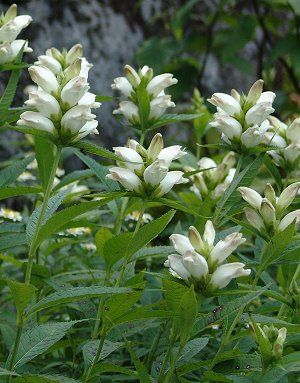  |
|
moimoi
AV Clubber  
Posts: 5,090 
|
Post by moimoi on Apr 24, 2016 21:57:33 GMT -5
Forum Faves & RequestsGreetings, Forum! And happy Spring! It’s a lovely day here in Chicago, so what better time to celebrate some of our favorite members of Kingdom Plantae? We start with some “blue flowers” as requested by DLΘ, followed by the Genus Lobelia (since I couldn’t find much info on Queen Bitch’s Lobelia dunbarii, or L. dunbariae, aside from the fact that it’s a threatened native species of the Hawaiian island of Molaka'i, per Swedish Wikipedia) and Lupin’s Triffids. A full entry on songstarliner’s succulents is slated for 7/17, since succulents, cacti, and bromeliads are a fascinating subset of about 60 different plant families. Look for the rest of your faves in upcoming entries, and thanks again for reading my little thread! Genus Gentiana (suggested by Lord Lucan) Origin: A cosmopolitan genus, occurring in alpine habitats in temperate regions of Asia, Europe and the Americas. Some species also occur in northwestern Africa, eastern Australia, and New Zealand. Features: Gentians have oppositely arranged leaves, sometimes in a basal rosette. The trumpet-shaped flowers are usually deep blue or azure, but can be white, cream, yellow, or red. Many species are polymorphic with respect to flower color, bearing flowers of different colors. Blue-flowered species predominate in the Northern Hemisphere, with red-flowered species dominant in the Andes, where bird pollination is probably more often favored by natural selection. White-flowered species are scattered throughout the range of the genus but dominate in New Zealand. Fun Facts:
- The genus name is a tribute to Gentius, an Illyrian king who may have been the discoverer of tonic properties in gentians.
- Gentian root is a common beverage flavoring for bitters. The soft drink Moxie contains gentian root, along with an alpine distilled beverage called Gentian. The French liqueur Suze and the Italian Aperol are made with gentian root. Americano apéritifs contain gentian root for bitter flavoring as well, and it is the main flavor in the German after-dinner digestif called Underberg. Gentian root is the main ingredient in Angostura bitters.
- Gentiana verna (Spring Gentian) is the county flower of Durham in the United Kingdom and appeared on the design of a Great Britain stamp, issued in 1964 to mark the 10th International Botanical Congress held in Edinburgh. A number of superstitions are associated with the Spring Gentian. For example, it is considered bad luck to bring the gentian into a house, as the individual would risk being struck by lightning. Also, folklore suggested that death would follow if the flower was ever picked.
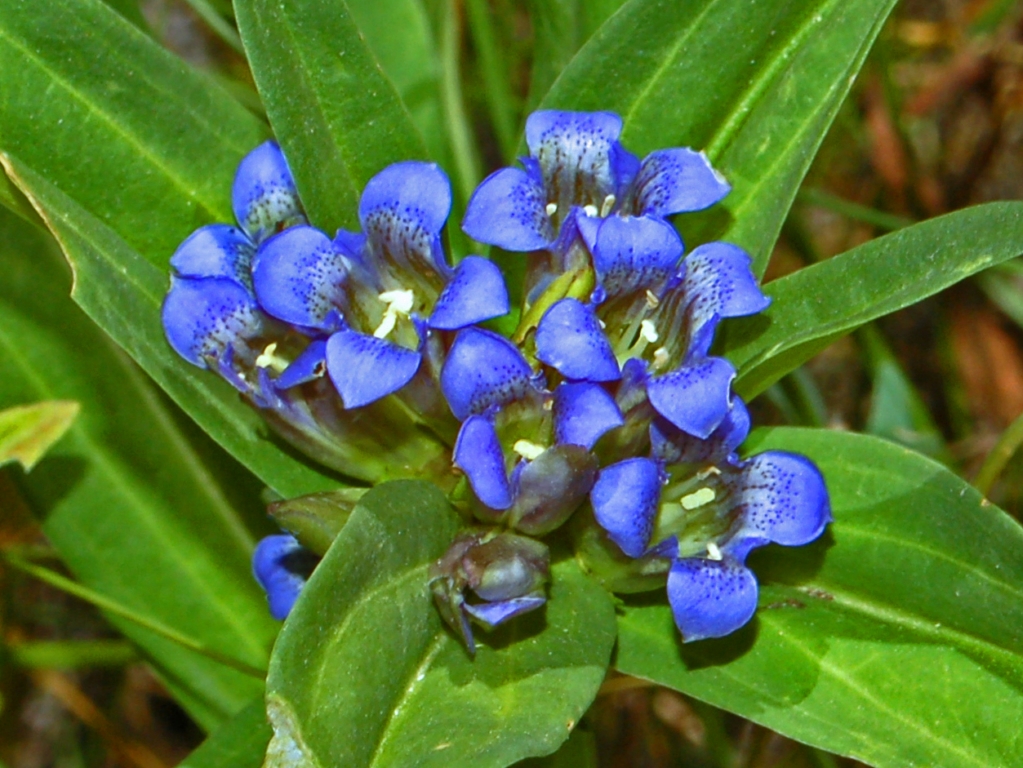  
Genus Meconopsis (Welsh and Himalayan Poppies)
Origin: A single species, Meconopsis cambrica (Welsh poppy), is indigenous to England, Wales, Ireland, and the fringes of Western Europe, although recent studies suggest that it does not belong in the genus. The other 40 or so (depending on classification) species are found in the Himalayas. Features: The plants rise to about four feet. The soft leaves and stems are covered in golden hairs, topped with just three or four pendant blossoms. Poppies are lactiferous, producing latex, which may be milky or watery, coloured or plain. Fun Facts:
- Meconopsis grandis, known as the blue poppy, is the national flower of Bhutan. Blue poppies do not produce opium.
- In the late spring of 1922, a British Himalayan expedition, led by legendary mountaineer George Leigh Mallory, discovered the blue poppy on a failed attempt to reach the summit of the then-unconquered Mount Everest. The flowers were introduced to much excitement at the Royal Horticultural Society's spring show of 1926.
- Native to the cold but sunny Himalayas, blue poppies are nearly impossible to grow below 10,000 feet. Longwood Gardens in Kennett Square, Pa is one of very few places in the United States to see them, along with parts of the Pacific Northwest and Alaska. The plant can neither be propagated nor made to re-flower the following year, even in the controlled environment of the greenhouse, which must be kept below 65 degrees F at all times.(On the other hand, the Welsh Poppy is sometimes considered a weed, albeit a handsome one, due to its vigorous self-seeding.)
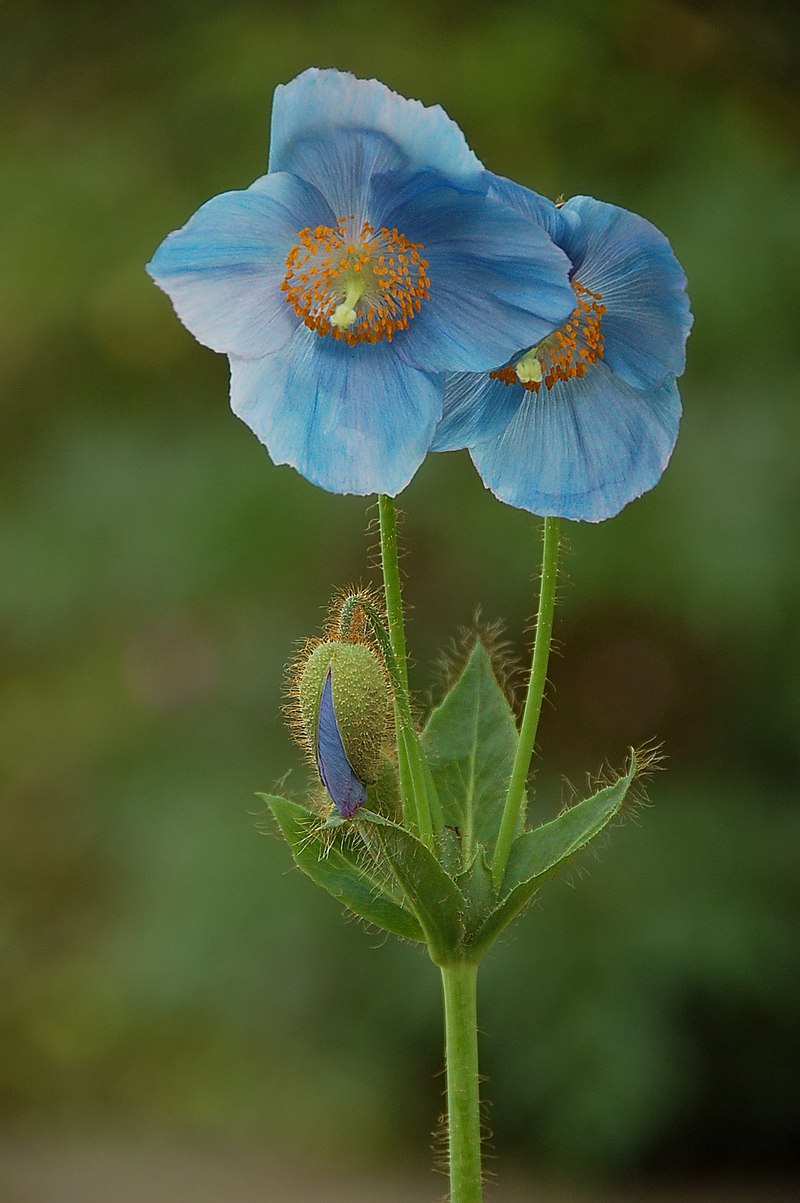  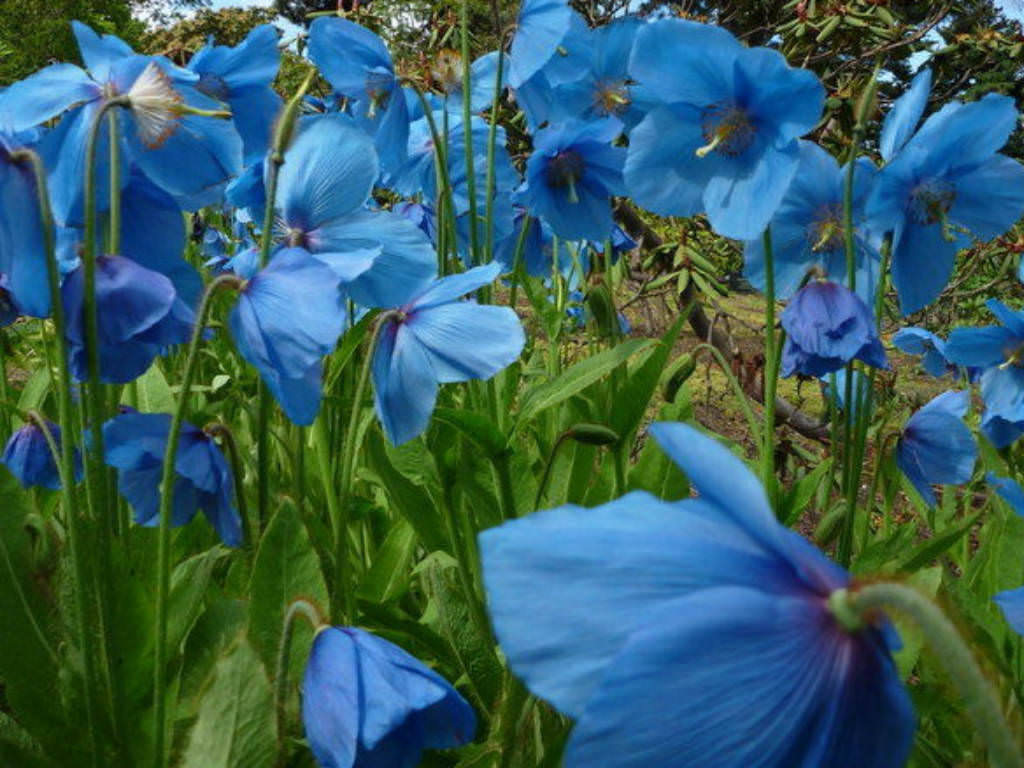 Genus Lobelia Genus Lobelia
Origin: Lobelia have a subcosmopolitan distribution, primarily in tropical to warm temperate regions of the world, with a few species extending into cooler temperate regions. Features: The genus Lobelia comprises a substantial number of large and small annual, perennial and shrubby species, hardy and tender, from a variety of habitats, in a range of colours. Many species appear totally dissimilar from each other. However, all have simple, alternate leaves and two-lipped tubular flowers, each with five lobes. The upper two lobes may be erect while the lower three lobes may be fanned out. Flowering is often abundant and the flower color intense, hence their popularity as ornamental garden subjects Fun Facts:
- Hawaiian lobelioids such as the L. dunbarii are currently classified in several genera and are thought to originate from a single introduction to a now-submerged Hawaiian Island 13-15 million years ago, probably from a Lobelia-like species arriving from Asia. This is the largest plant radiation in the Hawaiian Islands, and indeed the largest on any island archipelago, with over 125 species. Many species have beautiful and spectacular flowers. Unfortunately, they are also highly vulnerable to feeding by ungulates such as feral pigs. The bark contains a milky (but apparently non-poisonous) latex often chewed by rats and pigs and seedlings are vulnerable to disturbance by digging.
- Native Americans used Lobelia to treat respiratory and muscle disorders, and as a purgative. In Appalachian folk medicine, Lobelia has been used as "asthmador", an over-the-counter remedy for asthma and Lobelia inflata (Indian tobacco) has similarities to nicotine that have caused some to try it as an aid to quit smoking. However, studies indicate that it has adverse effects and is not an effective remedy.
Two species, L. siphilitica and L. cardinalis, were once considered a cure for syphilis.
- The eccentric New Englander Elias Smith, a preacher and alternative medicine advocate, identified Lobelia (a.k.a. pukeweed) as the 'plant of renown' referred to in Ezekiel 34:29. Believing that the United States held eschatological significance, Smith believed that this plant was provided by God to democratize medical treatment, just as Smith's preaching was a democratization of theology.
- One species, Lobelia chinensis (called bàn biān lián, 半边莲 in Chinese), is one of the fifty fundamental herbs in traditional Chinese medicine.
- In the Victorian language of flowers, the Lobelia symbolizes malevolence.
   
Triffidus celestus (Triffid)
Origin: Originally thought to be extraterrestrial in origin, it has been speculated that triffids were the creation of Soviet biologist Trofim Lysenko--first coming to the attention of the Western world when a man named Umberto Christoforo Palanguez presented the Arctic & European Fish Oil Company with a mysterious vegetable oil originating from Russia. Once the scientists of Arctic & European realized how potent the oil was, they accepted Palanguez' offer to smuggle some seeds of the plant out of Russia. Palanguez disappeared, but his plane carrying triffid seeds was shot down by the Red Air Force, allowing the seeds to be carried all over the globe by wind. The first triffid outbreaks occurred in Indochina, where they received little press attention until appearing in Sumatra, Borneo, Belgian Congo, Colombia, Brazil and other equatorial regions. Although they developed faster in tropical zones, triffids soon established themselves worldwide outside the polar and desert regions. Features: Triffid can be divided into three components: base, trunk, and head (which contains a venomous sting). Adult triffids are described as approximately 7-8 feet (2.1-2.4 m) in height in Europe, while those in tropical areas can reach 10 feet (3.0 m). A small number of North American triffids reportedly reach 60 feet (18 m) in height. The base of a triffid is a large muscle-like root mass, comprising three blunt appendages. When dormant, these appendages draw nutrients, as on a normal plant. When active, triffids use these appendages to propel themselves. Above the base are upturned leafless sticks which the triffid drums against its stem. The exact purpose of this is not fully explained, but my play a part in communication, mating, or echolocation. The upper part of a triffid consists of a stem ending in a funnel-like formation containing a sticky substance which traps insects, much like a pitcher plant. Also housed within the funnel is a stinger which, when fully extended, can measure 10 feet (3.0 m) in length. When attacking, a triffid will lash the sting at its target, primarily aiming for its prey's face or head, with considerable speed and force. Contact with bare skin can kill a person instantly. Once its prey has been stung and killed, a triffid will root itself beside the body and feed on it as it decomposes. Fun Facts:
- Triffids were nearly exterminated for their predatory nature until identified as the source of a valuable oil that could help reduce worldwide dependence on fossil fuels.
- Docking their stingers renders them harmless, and docked triffids have become fashionable in public and private gardens. As it takes triffids two years to fully regrow their stings, captive triffids are safe if pruned annually. Triffid farms produce triffid oil, which is of greater quality when taken from undocked specimens.
- After a large part of the Earth's human population was rendered blind by a brightly coloured comet shower, triffids escaped confinement and killed large numbers of people. They soon overran mainland Europe and the British Isles, thus forcing the majority of survivors to escape to the Isle of Wight and other islands. In North America, members of the Algonquin tribe escaped attack due to their immunity to triffid venom.
- The triffid is the titular antagonist in John Wyndham's 1951 novel The Day of the Triffids and Simon Clark's 2001 sequel The Night of the Triffids. Triffids were also featured in the 1957 BBC radio dramatization of Wyndham's book, a considerably altered 1962 film adaptation, a more faithful 1981 television serial produced by the BBC, and in a 2009 two-part TV series also produced by the BBC.

 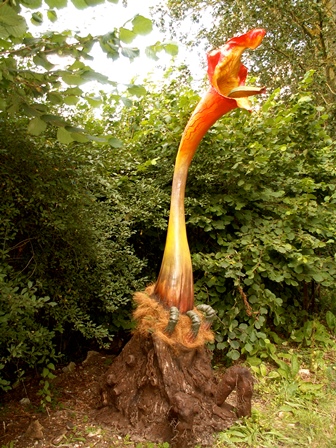 
|
|
|
|
Post by Desert Dweller on Apr 24, 2016 22:20:53 GMT -5
Love the entry on the triffid! Thanks!
Also, all the blue flowers are beautiful. Great idea.
|
|
|
|
Post by haysoos on Apr 29, 2016 12:03:09 GMT -5
I had my gaming group infiltrate and raid a Fourth-Reich genetic engineering project in Brazil. I was sorely disappointed when they did not recognize the mobile plants with the blinding stingers. They were able to avoid complete GM disapproval by being appropriately appreciative of the piranhamoose.
|
|
moimoi
AV Clubber  
Posts: 5,090 
|
Post by moimoi on May 9, 2016 2:33:01 GMT -5
Kinetic PlantsUnlike what we were told in kindergarten, plants can move – not just at undetectable rates of growth, but rapid movements that can be clocked in mph. Darwin’s last work before he died, The Power of Movement in Plants is a study of phototropism and other types of plant movement, including seed/pollen dispersal, capturing prey, and self-defense. Explaining how plants move using gas and water pressure is complicated and this post is already late so…some examples below: Exhibit A: Morus alba (White Mulberry)
Origin: Native to northern China, it has been grown widely from the Indian subcontinent west through Iran to southern Europe for over a thousand years. The species is also widely cultivated and naturalized elsewhere (United States, Mexico, Australia, Kyrgyzstan, Argentina, etc.) Features: The trees are generally deciduous in temperate regions, but trees grown in tropical regions can be evergreen. Male and female flowers are usually on separate trees. The fruit is 1–2.5 cm long; in the wild, fruit is deep purple, but in many cultivated plants it varies from white to pink, with a bland flavor compared to red or black mulberries. Fun Facts:
- Cultivation of white mulberry for silkworms began over four thousand years ago and to this day, white mulberry leaves are the preferred feedstock in the commercial production of silk. The species is notable for the rapid release of its pollen through stamens which act as catapults, releasing stored elastic energy in just 25 µs. The resulting movement is approximately 350 miles per hour (560 km/h), over half the speed of sound, making it the fastest known movement in the plant kingdom.
- A fruitless mulberry was developed from a clone for use in the production of silk in the U.S. The industry never materialized, but the mulberry variety is now used as an ornamental tree widely naturalized in disturbed areas such as roadsides and the edges of tree lots throughout urban areas of North America, where it hybridizes readily with a locally native red mulberry (Morus rubra). There is now serious concern for the long-term genetic viability of red mulberry because of extensive hybridization in some areas. As a result, it is listed as an invasive plant in parts of North America.
- In traditional Chinese medicine, the fruit is used to treat prematurely grey hair, to "tonify" the blood, and treat constipation and diabetes. The bark is used to treat cough, wheezing, edema, and to promote urination. It is also used to treat fever, headache, red dry and sore eyes. The root bark exhibits antibacterial activity against food poisoning micro-organisms. Albanol A, isolated from the root bark extract of M. alba, may be a promising lead compound for developing an effective drug for treatment of leukemia.
- The "White Mulberry Tree" is title of a crucial chapter in Willa Cather's 1913 novel, O Pioneers!, in which two forbidden lovers are killed, a reference a Babylonian story that was later incorporated into Greek and Roman mythology which attributes the reddish purple color of the white mulberry fruits to the tragic deaths of the lovers Pyramus and Thisbe.
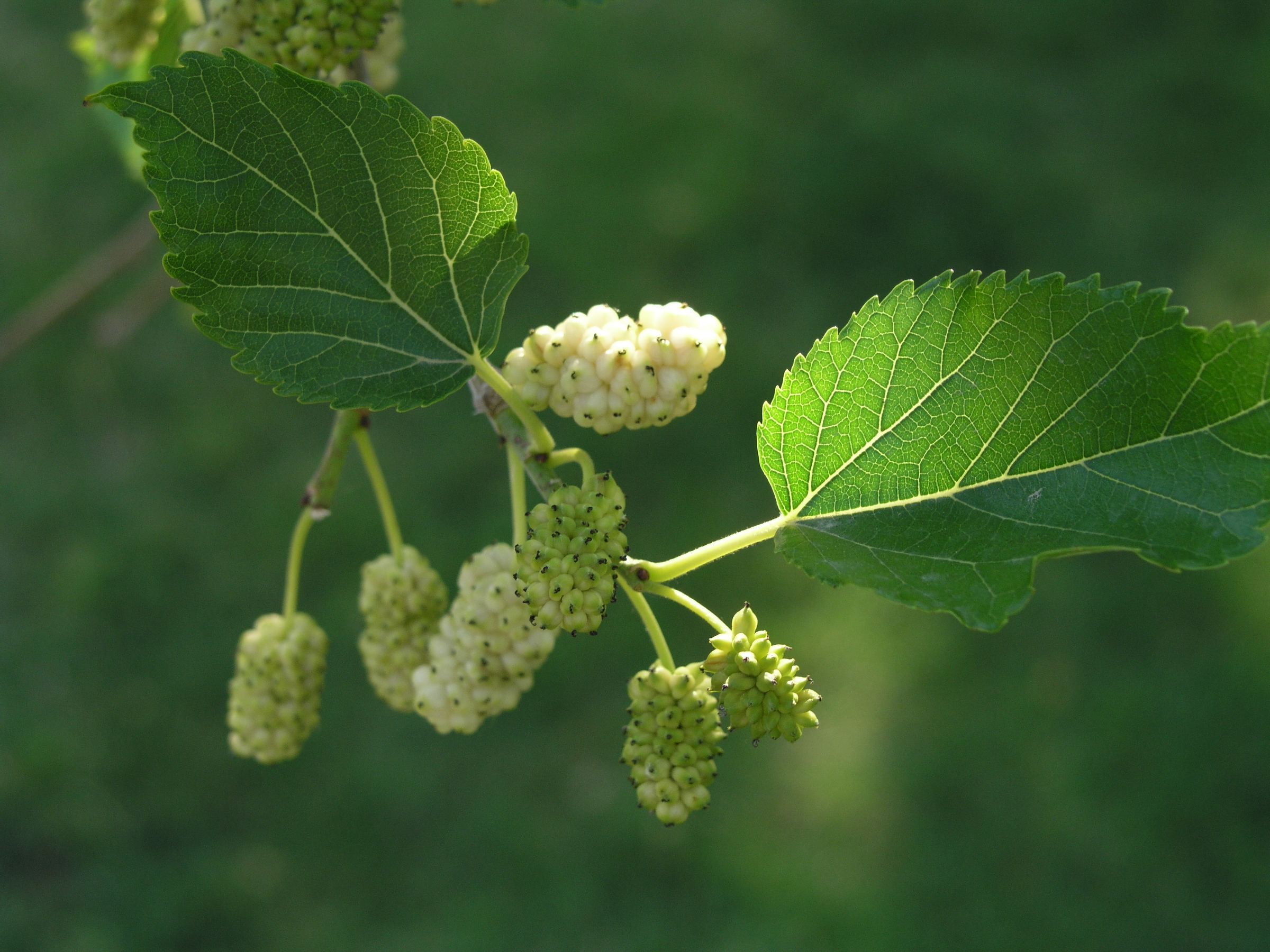  ![]() Exhibit B: Selaginella lepidophylla (Rose of Jericho, Stone Flower, Resurrection Moss, Siempre Viva) Exhibit B: Selaginella lepidophylla (Rose of Jericho, Stone Flower, Resurrection Moss, Siempre Viva)
Origin: native to the Chihuahuan Desert Features: S. lepidophylla is noted for its ability to survive almost complete desiccation. During dry weather in its native habitat, its stems curl into a tight ball and uncurl only when exposed to moisture. It is one of a few desert species that propagate as tumbleweeds. Apart from its spores, the tissues of the tumbleweed structure are dead so that the structure may degrade gradually and fall apart, releasing spores during tumbling, or germinating after the tumbleweed has come to rest in a wet location. Fun Facts: - The ability of the plant to survive extreme desiccation was noted by Spanish missionaries when they reached the New World, including the area that was to become the United States. The missionaries used the plant to demonstrate to potential native converts the concept of being reborn.
- This plant has been used as an herbal medicine. An infusion (tea) is made by steeping a tablespoon of dried material in hot water and the tea is used as an antimicrobial in cases of colds and sore throat.
![]()  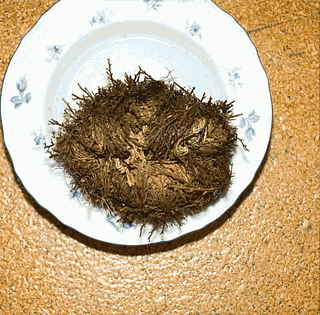 
Exhibit C: Codariocalyx motorius (Telegraph Plant, Semaphore Plant, Dancing Grass)
Origin: It is widely distributed South and Southeast Asia, including islands of the Pacific Rim Features: Resembling a small palm tree, it produces small, purple flowers. Each leaf is equipped with a hinge that permits it to be moved to receive more sunlight, but the weight of these leaves means the plant must expend a lot of energy in moving it. To optimize its movement, each large leaf has two small leaflets at its base. These move constantly along an elliptical path, sampling the intensity of sunlight, and directing the large leaf to the area of most intensity. Another hypothesis has been offered that the rapid movements are intended to deter potential predators. Fun Facts:
- The common name is due to the rotation of the leaflets with a period of about three to five minutes; this was likened to a semaphore telegraph
- Per Southeast Asian legend: Once upon a time, there was a beautiful Dai girl named Duoyi. She loved dancing and danced skillfully. In gaps between the farming periods, she often toured villages of different ethnic groups to perform for the poor. However, one day a bandit robbed Duoyi and forced her to dance for him only. Duoyi didn’t follow and she escaped, committing suicide by drowning. People from the village salvaged her body and held a funeral. Over time, beautiful grasses grew from Duoyi’s grave, and they ‘dance’ whenever music starts. From then on, people called this plant ‘Dancing-grass’, and they believe the grasses are the incarnation of Duoyi.

Exhibit D: Genus Helianthus (Sunflower)
Origin: Except for three species in South America, all Helianthus species are native to North America. Features: Sunflowers are usually tall annuals that grow to a height of 50–400 centimeters (20–157 in). The rough and hairy stem is branched in the upper part in wild plants but usually unbranched in domesticated cultivars. The petiolate leaves are dentate and often sticky. The lower leaves are opposite, ovate or often heart-shaped. They bear one or several wide flower heads, with bright yellow ray florets at the outside and yellow or maroon disc florets inside. Several ornamental cultivars have red-colored ray florets; all of them stem from a single original mutant. During growth, sunflowers tilt during the day to face the sun, but stop once they begin blooming. This tracking of the sun in young sunflower heads is called heliotropism. By the time they are mature, sunflowers generally face east. Fun Facts:
- Sunflowers are especially well known for their symmetry based on Fibonacci numbers and the Golden angle.
- The Wikipedia disambiguation page lists the following Fictional Characters: The Sunflower Samurai (Samurai Champloo), Sunflower (Plants vs. Zombies) and Sunflower, a deleted character in Fantasia.
- In a 100 gram serving, dried whole sunflower seeds provide 584 calories as a nutrient-dense food. The seeds are an excellent source (20% or higher of the Daily Value, DV) of protein (42% DV), dietary fiber (36% DV), all B vitamins (23-129% DV) and vitamin E (234% DV). The seeds also contain high levels of the dietary minerals, magnesium, manganese, phosphorus, iron and zinc (40-94% DV).
- Sunflower oil can be used to run diesel engines when mixed with diesel in the tank. Due to the high levels of unsaturated fats, there is higher viscosity in cold temperatures.
- Regarding his series of sunflower paintings, in a letter to his brother Theo, Vincent Van Gogh wrote: "It is a kind of painting that rather changes in character, and takes on a richness the longer you look at it. Besides, you know, Gauguin likes them extraordinarily. He said to me among other things – 'That...it's...the flower.' You know that the peony is Jeannin's, the hollyhock belongs to Quost, but the sunflower is somewhat my own."
   See also: Dynamite Tree, Javan Cucumber, Exploding Cucumber, Squirting Cucumber, Sensitive Plant, Morning Glory
|
|
|
|
Post by haysoos on May 9, 2016 8:22:29 GMT -5
Some of my favourite botanical kinetics come from exploding seed pods:
This reminded me that I have a Selaginella (which I believe was sold as a "Dinosaur Plant"). I bought it thinking it was probably one of the few plants I would not be able to kill. It must be in one of the boxes of stuff that I still haven't unpacked since my last move... about eight years ago. I wonder if it's still viable? This is why I am only allowed to have plastic plants now.
They have sunflowers in Minecraft. I am rather disappointed that they don't turn to face the sun, but rather always face east. Which is at least a nod to heliotropism, but kind of exactly the opposite of what the real flowers do.
|
|
|
|
Post by ganews on May 9, 2016 12:41:52 GMT -5
More notes from Wifemate's residency at Denver Botanic Gardens last year: she collaborated with a scientist on a species of Corispermum (tumbleweed) in northern Colorado, going on a field trip to collect samples and illustrating seeds through the microscope. It covered a very small region and was officially some flavor of endangered.
|
|
moimoi
AV Clubber  
Posts: 5,090 
|
Post by moimoi on May 23, 2016 2:43:13 GMT -5
Whimsical PlantsWe’ve established that plants move, but how about talking? According to the eminent scholar L. Carroll, tiger lilies talk when there’s anybody worth talking to, “and a great deal louder.” Trees are protectors of a garden, with their bark and shouts of “bough-wough”. And if the flowers in your garden aren’t talking, it’s because you’ve made the beds too soft and put them to sleep. No worries, though, as the renowned Dr. Suess observed, “be grateful you are not in the forest in France where the average person just hasn’t a chance to escape from the perilous pants-eating plants.” But your pants are safe; you’re a fortunate guy. You ought to be shouting ‘how lucky am I’ as you read about these whimsical plant species: Exhibit A: Genus Passiflora (Passionflower)
Origin: South America, Southern United States Features: Passion flowers have a unique structure, which in most cases require a large bee to effectively pollinate. The leaves are food for the larva of a number of butterflies. To prevent butterflies from laying too many eggs on any single plant, some passion flowers bear small, colored nubs which resemble the butterflies' eggs and seem to fool them into believing that more eggs have already been deposited on a plant than actually is the case. Also, many Passiflora species produce a sweet nutrient-rich liquid from glands on their leaf stems. These fluids attract ants which kill and eat any pests that they find feeding on the passion flowers.
Fun Facts: - Spanish Christian missionaries used passionflowers to teach the story of Jesus’s crucifixion in a rather inventive way. The climbing tendrils were used to describe the whips used in flagellation, the flower’s ten petals and sepals were said to be the apostles, minus Judas and St. Peter the denier, the ring of 100 filaments was said to represent the crown of thorns, and the three stigma and five anthers were used to represent the three nails and five wounds.
- In India, blue passionflowers are called Krishnakamala and colloquially called 'Paanch Paandav'. The flower's structure lends itself to the interpretation along the lines of five Pandavas, the Divine Krishna at center, and the opposing hundred at the edges. The color blue is moreover associated with Krishna as color of his aura.
- Outside the Christian world, the regularly shaped flowers have reminded people of the face of a clock. In Israel they are known as "clock-flower" (שעונית) and in Greece as "clock plant" (ρολογιά); in Japan too, they are known as tokeisō (時計草, "clock plant"). In Turkey, the shape of the flowers reminds people of the Rota Fortunae and it is called Çarkıfelek.
- Historically, the plant been used as an herbal or homeopathic medicine to treat nervous anxiety and insomnia. The dried, ground herb is frequently used in Europe by drinking a teaspoon of it in tea. Passionflower is officially included in the national pharmacopoeias of France, Germany, and Switzerland. In other parts of the world such as India and the Middle East, it has been used to treat morphine dependence. It is also a common folk remedy in Africa and may be used to produce organic sunscreens.
 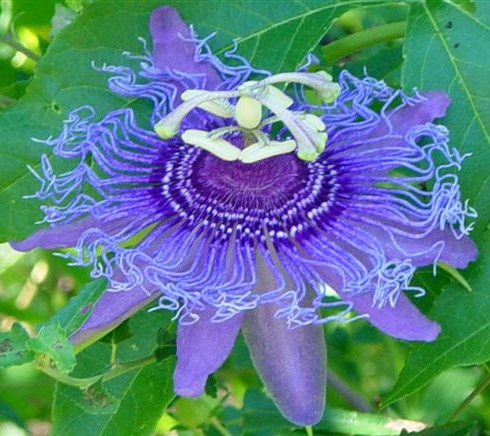 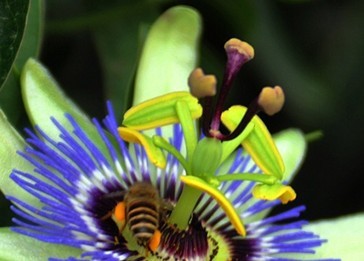 
Exhibit B: Adansonia digitata (Baobab Tree, Monkey Bread Tree, Upside Down Tree)Origin: Sub-Saharan Africa Features: The trees usually grow as solitary individuals and are large and distinctive elements of savanna or scrubland vegetation. All baobab trees are deciduous, losing their leaves in the dry season, and remains leafless for nine months of the year. The baobab's compound leaves with normally five (but up to seven) leaflets are akin to a hand. They can grow to between 5–25 m (16–82 ft) in height. The trunk tends to be bottle-shaped and can reach a diameter of 10–14 m (33–46 ft). The span of the roots actually exceed the tree's height, a factor that enables it to survive in a dry climate. During the early summer (October to December in southern hemisphere) the tree bears very large, heavy, white flowers that open during the late afternoon and stay open for 24 hours to be pollinated by fruit bats. The fruit are large, egg-shaped capsules filled with pulp that dries, hardens, and falls to pieces which look like chunks of powdery, dry bread. Fun Facts:- Their maximum age, which is subject to much conjecture, seems to be around 1,500 years. Explorers of old were inclined to carve their names on baobabs, and many are defaced by modern graffiti. Around Gweta, Botswana, Chapman's Baobab, also known as Seven Sisters or Xaugam, is named for the explorer James Chapman, but is also taken to be a camping site of Livingstone and Selous. It had a circumference of 25m before its constituent trunks collapsed outward in 2016. It is not confirmed dead, however. The tree was historically used as a navigation beacon and as a post office by passing explorers, traders and travelers, many of whom left inscriptions on its trunk. At Saakpuli in northern Ghana, the site of a 19th century slave transit camp is marked by a stand of large baobabs, to which slaves were chained. The chains were wrapped around the baobab trunks or around the roots.
- The African baobab's fruit contains 50% more calcium than spinach, is high in antioxidants, and has three times the vitamin C of an orange. The dry pulp is either eaten fresh or dissolved in milk or water to make a drink. The leaves can be eaten as relish.
- African bushman legend states that Thora, the god, took a dislike to the Baobab growing in his garden, so he threw it over the wall of Paradise onto the Earth below. The tree landed upside down and continued to grow. In Zambia, one baobab is said to be haunted by a ghostly python. A long time ago, the python lived in the hollow trunk and was worshipped by the natives. A white hunter shot him down, and led to bad consequences. In Kafue National Park, one of the largest Baobabs is known as "Kondanamwali” or the “tree that eats maidens.” As the story goes, the tree fell in love with four beautiful maidens. When they reached puberty, they made the tree jealous by finding husbands. So, one night, during a thunderstorm, the tree opened its trunk and took the maidens inside. Interestingly enough, a rest house has been built in the branches of the tree. On stormy nights, it is said that the crying of the imprisoned maidens can still be heard. Along the Zambezi, the tribes believe that baobabs were upright and too proud. The gods became angry and uprooted them and threw them back into the ground upside-down. Evil spirits now cause bad luck to anyone that picks up the sweet white flowers. More specifically, a lion will kill them. In contrast some believe that if one drinks from water in which Baobab seeds have soaked, you will be safe from crocodile attacks. Along the (great gray greasy) Limpopo River, it is thought that when a young boy is bathed in the water used to soak baobab bark, he will grow up into a big man.
  
Exhibit C: Genus Plumeria (Frangipani)Origin: native to Central America, Mexico, the Caribbean, and South America as far south as Brazil but can be grown in tropical and sub-tropical regions Features: Each of the separate species of Plumeria bears differently shaped alternate leaves with distinct form and growth habits. For example, the leaves of P. alba are quite narrow and corrugated, whereas leaves of P. pudica have an elongated shape and glossy, dark-green color. P. pudica is one of the everblooming types with non-deciduous, evergreen leaves. Plumeria flowers are most fragrant at night in order to lure moths to pollinate them. The flowers have no nectar, however, and simply dupe their pollinators. Fun Facts:- The common name 'frangipani' comes from an Italian noble family, a sixteenth-century marquess of which invented a plumeria-scented perfume. In India, it is called 'champa' and makes up the scent 'nag champa' along with sandalwood. In Cantonese, it is known as 'gaai daan fa' or the 'egg yolk flower' tree. In Indonesia, where the flower has been commonly associated with Balinese culture, it is known as 'kamboja' and the Hawaiian name is 'melia'
- In Mesoamerica, Plumerias have carried complex symbolic significance for over 2000 years, with striking examples from the Mayan and Aztec periods. They are associated with temples in both Hindu and Buddhist cultures. The scent of the Plumeria has been associated with a vampire in Malay folklore called the pontianak and throughout Southeast Asia, frangipani trees are often planted in cemeteries.
- Notable literary references include:
1819 - P. B. Shelley "The champak odours fail / Like sweet thoughts in a dream," line from "Indian Serenade".
1890 - In Oscar Wilde's The Picture of Dorian Gray, Lord Henry's wife's perfume leaves the scent of frangipani to linger in the room, likely referencing the work of Huysmans.
1913 - Rabindranath Tagore story entitled "The Champa Flower" from the collection Crescent Moon.
1957 - Doris Lessing's short story Flight, from her collection "The Habit of Loving" includes several references to the frangipani tree - "Her hair fell down her back in a wave of sunlight, and her long bare legs repeated the angles of the frangipani stems; bare, shining-brown stems among patterns of pale blossoms."
1985 - In the novel Perfume: The Story of a Murderer by Patrick Süskind, the character Baldini wears it.
1999- Tori Amos mentions frangipani in her song "Datura" released on her album To Venus and Back.
 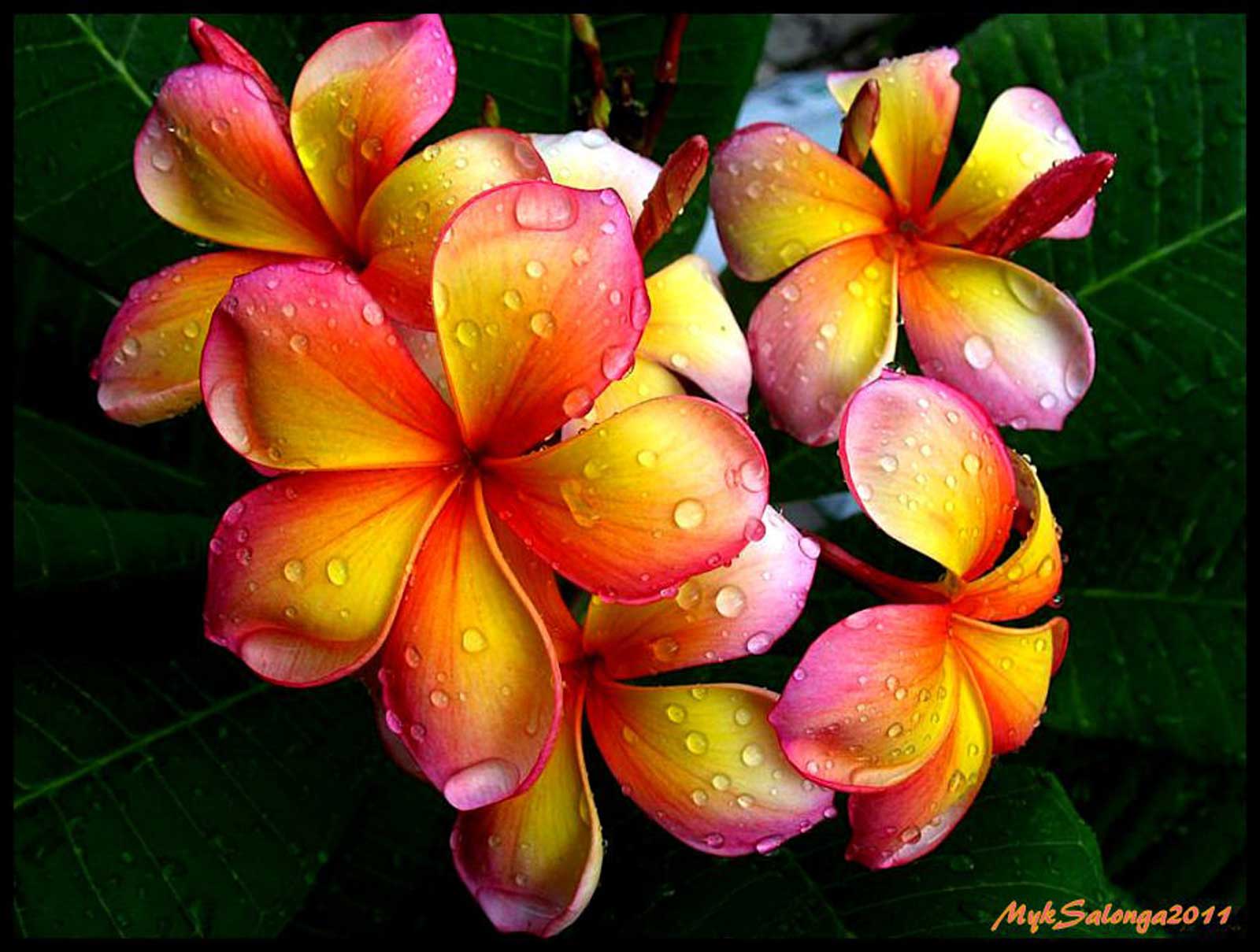  Exhibit D: Ziziphus jujube (Jujube, Indian Date, Chinese Date, Korean Date) Exhibit D: Ziziphus jujube (Jujube, Indian Date, Chinese Date, Korean Date)
Origin: South Asia, China Features: It is a small deciduous tree or shrub reaching a height of 5–12m (16–39 ft), usually with thorny branches.The fruit is an edible oval drupe 1.5–3 cm deep; when immature it is smooth-green, with the consistency and taste of an apple, maturing brown to purplish-black and eventually wrinkled, looking like a small date. There is a single hard stone similar to an olive stone. Fun Facts:- The freshly harvested as well as the candied dried fruit are often eaten as a snack, or with coffee. On his visit to Medina the nineteenth century English explorer, Sir Richard Burton, observed that the local variety of jubube fruit was widely eaten. He describes its taste as "like a bad plum, an unrepentant cherry and an insipid apple." The plant has no relation to the candy confection by the same name, though it may have served as inspiration for the Laotian drag performer known as Jujube.
- Ziziphin, a compound in the leaves of the jujube, suppresses the ability to perceive sweet taste. The fruit, being mucilaginous, is very soothing to the throat and decoctions of jujube have often been used in pharmacy to treat sore throats. The fruit and its seeds are used in Chinese and Korean traditional medicine, where they are believed to alleviate stress, and traditionally for anti-fungal, anti-bacterial, anti-ulcer, anti-inflammatory purposes. A controlled clinical trial found the fruit helpful for chronic constipation.
- In Japan, it is known as natsume and has given its name to a style of similarly-shaped tea caddy used in the Japanese tea ceremony. It is also the namesake for nightlights (ナツメ球), again due to the similarity between the shape of the bulb and the fruit. In Korea, the wood is used to make the body of the taepyeongso, a double-reed wind instrument. The wood is also used to make Go bowls, beads, and violin parts.
- In Arabic-speaking regions, it is thought that the jujube is related to the lote-trees (sing. sidrah, pl. sidr) which are mentioned in the Qur'an. In Palestine, a related species, the Ziziphus spina-christi is called sidr and believed to be the origin of Christ’s crown of thorns.
  See also: Genus Allium See also: Genus Allium (inspiration for Suess’s Truffula Tree), Genus Dahlia, Genus Scadoxus, Genus Hoya, Checkered Lily, Toad Lily, Flame Lily
|
|
|
|
Post by Return of the Thin Olive Duke on May 23, 2016 3:22:27 GMT -5
Of the Baobab, the traditions of peoples along the Niger and Senegal say the Devil stuck them in upside-down out of spite.
|
|
|
|
Post by PA Noire on May 25, 2016 9:35:00 GMT -5
I need to post a picture of this goddamn bush in my backyard. It's blooming and I swear it's like mace to me.
|
|
moimoi
AV Clubber  
Posts: 5,090 
|
Post by moimoi on May 28, 2016 11:14:01 GMT -5
|
|
moimoi
AV Clubber  
Posts: 5,090 
|
Post by moimoi on Jun 4, 2016 1:30:23 GMT -5
moimoi , I don't know if you take requests or not, but if you do I have one--I've long been interested in famine crop plants like pokeweed, grass pea, and noni. Y'know, plants that are not normally widely eaten due to issues of taste or toxicity, but that have served as emergency food sources in times of trouble. I always enjoy your writeups and I feel you could do a really interesting article on the topic. Thanks for considering, either way! Thanks PatBat! I'm down to cover famine crops - if not in one of the 'edibles' posts coming up, then with the succulents that songstarliner requested on 7/17. |
|
moimoi
AV Clubber  
Posts: 5,090 
|
Post by moimoi on Jun 5, 2016 14:53:22 GMT -5
Exotic Edibles
Ah, summertime – when the world is ripe for exploration. Whether one is jetting off for vacation or just seeing what’s on display at the neighborhood grocer/fruit stand, now is the ideal time to pick up something mysteriously shaped, brightly colored, and curiously scented to chop up or throw in a blender (just watch out for poison). Here’s a brief field guide for culinary adventurers: Exhibit A: Genus Durio (Durian)
Origin: The durian is native to Brunei, Indonesia and Malaysia. There is some debate as to whether the durian is native to the Philippines, particularly the island of Mindanao, or was introduced. The center of ecological diversity for durians is the island of Borneo. The durian is grown in other areas with a similar climate, but it is strictly tropical and stops growing when mean daily temperatures drop below 22 °C (72 °F). Features: The durian is the fruit of several tree species belonging to the genus Durio. The name "durian" is derived from the Malay-Indonesian languages word for duri or "spike", a reference to the numerous spiky protuberances of the fruit. Regarded throughout Southeast Asia as the 'king of fruits', the durian is distinctive for its large size, strong odor, and formidable husk. The fruit can grow as large as 30 centimeters (12 in) long and 15 centimeters (6 in) in diameter, and it typically weighs one to three kilograms (2-7 lb). Its shape ranges from oblong to round, the color of its husk from green to brown, and its flesh from pale yellow to red, depending on the species. There are 30 recognized Durio species, at least nine of which produce edible fruit, and over 300 named varieties in Thailand alone. Durio zibethinus is the only species available in the international market; other species are sold only in their local regions and there are hundreds of durian cultivars. Durian flowers are large and feathery with copious nectar, and give off a heavy, sour, and buttery odor, typical of flowers pollinated primarily by bats. Fun Facts:
- D. zibethinus is the only species commercially cultivated on a large scale and available outside of its native region. In the species name, zibethinus refers to the Indian civet, Viverra zibetha. There is disagreement regarding whether this name, bestowed by Linnaeus, refers to civets being so fond of the durian that the fruit was used as bait to entrap them, or to the durian smelling like the civet.
- The unusual flavor and odor of the fruit have prompted many to express diverse and passionate views, ranging from deep appreciation to intense disgust. In 1856, the British naturalist Alfred Russel Wallace remarked, “its consistence and flavour are indescribable. A rich custard highly flavoured with almonds gives the best general idea of it, but there are occasional wafts of flavour that call to mind cream-cheese, onion-sauce, sherry-wine, and other incongruous dishes. Then there is a rich glutinous smoothness in the pulp which nothing else possesses, but which adds to its delicacy. It is neither acidic nor sweet nor juicy; yet it wants neither of these qualities, for it is in itself perfect. It produces no nausea or other bad effect, and the more you eat of it the less you feel inclined to stop.” Novelist Anthony Burgess writes that eating durian is "like eating sweet raspberry blancmange in the lavatory" and chef/travel writer Anthony Bourdain notes that after consuming durian, “Your breath will smell as if you'd been French-kissing your dead grandmother.” The wide range of descriptions for the odor of durian may have a great deal to do with the variability of durian odor itself, coming from different species, and of variations in people's olfactory receptors. Three scientific analyses of the composition of durian aroma – from 1972, 1980, and 1995 – each found a mix of volatile compounds including esters, ketones, and different sulfur compounds, with no agreement on which may be primarily responsible for the distinctive odor.
- A common local belief is that the durian is harmful when eaten with coffee or alcoholic beverages. Several medical investigations on the validity of this belief have been conducted with varying conclusions, though a study by the University of Tsukuba finds the fruit's high sulfur content inhibits the activity of aldehyde dehydrogenase, causing a 70% reduction of the ability to clear toxins from the body. On a related note, the Javanese believe durian to have aphrodisiac qualities, and impose a set of rules on what may or may not be consumed with it or shortly thereafter. A saying in Indonesian, durian jatuh sarung naik, meaning "the durian falls and the sarong comes up", refers to this belief. Warnings against the supposed lecherous quality of this fruit soon spread to the West – the Swedenborgian philosopher Herman Vetterling commented on so-called "erotic properties" of the durian in the early 20th century.
- A common saying is that a durian has eyes and can see where it is falling because the fruit allegedly never falls during daylight hours when people may be hurt. A saying in Indonesian, ketiban durian runtuh, which translates to "getting a durian avalanche", is the equivalent of the English phrase "windfall gain". Nevertheless, signs warning people not to linger under durian trees are found in Indonesia, and wearing a hardhat is recommended when collecting the fruit. Strong nylon or woven rope nettings are often strung between durian trees in orchards, serving a threefold purpose: the nets aid in the collection of the mature fruits, deter ground-level scavengers, and most importantly, prevent the durians from falling onto people.
- In Asian popular culture: The durian symbolized the subjective nature of ugliness and beauty in Hong Kong director Fruit Chan's 2000 film Durian Durian (榴槤飄飄, lau lin piu piu), and was a nickname for the reckless but lovable protagonist of the eponymous Singaporean TV comedy Durian King played by Adrian Pang. Likewise, the oddly shaped Esplanade building in Singapore is often called "The Durian" by locals, and "The Big Durian" is the nickname of Jakarta,Indonesia. Being a fruit much loved by a variety of wild beasts, the durian sometimes signifies the long-forgotten animalistic aspect of humans, as in the legend of Orang Mawas, the Malaysian version of Bigfoot, and Orang Pendek, its Sumatran version, both of which have been claimed to feast on durians.
 .jpg) Exhibit B: Cucumis metuliferus (Horned Cucumber, Blowfish Fruit, Kiwano Melon)Origin: Exhibit B: Cucumis metuliferus (Horned Cucumber, Blowfish Fruit, Kiwano Melon)Origin: native to Sub-Saharan Africa, it is now grown in California, Mississippi, Chile, Australia, and New Zealand Features: An annual vine in the cucumber and melon family, the skin of an unripe kiwano is green but turns a deep yellow orange to orange color when the fruit ripens. The fruit has horn-like spines and jelly-like flesh with a tart taste, and texture similar to a cucumber. Fun Facts:
- C. metuliferus is a traditional food plant in Africa. It is one of the few sources of water during the dry season in the Kalahari Desert and in northern Zimbabwe it is primarily used as a snack or salad. The fruit can be used in cooking, but when eaten raw, most suck out the pulp and spit out the seeds. Some also eat the peel, which is very rich in vitamin C and dietary fiber.
- The fruit is undergoing a bit of a marketing push in the U.S. where upscale grocers tout it as a “Cuke-a-saurus” to entice (spoiled rich) kids to eat fruits and vegetables. The fruit's taste has been compared to a combination of cucumber and zucchini or a combination of banana, cucumber and lemon. It is also said to taste like an unripe, watered-down banana. A small amount of salt or sugar can increase the flavor. It has moderate levels of vitamins C as well vitamins A and some B vitamins. It also has iron, calcium and other minerals.
- The fruit was featured as the “Golano Melon” on the Star Trek: Deep Space Nine episode “Times Orphan”.
  Exhibit C: Plinia cauliflora (Jabuticaba, Brazilian Grape Tree) Exhibit C: Plinia cauliflora (Jabuticaba, Brazilian Grape Tree)
Origin: native to Minas Gerais and São Paulo states in Brazil, related species in the genus Myrciaria, are often referred to by the same common names and are native to Brazil, Argentina, Paraguay, Peru and Bolivia. Features: The tree is a slow-growing evergreen that can reach a height of 15 meters if not pruned. It has salmon-colored leaves when they are young, which turn green as they mature. Its flowers are white and grow directly from the trunk, followed by thick-skinned berries typically measuring 3–4 cm in diameter. The fruit has a thick, purple, astringent skin that encases a sweet, white or rosy pink gelatinous flesh. Embedded within the flesh are one to four large seeds, which vary in shape depending on the species. Fun Facts:
- Common in Brazilian markets, jabuticabas are largely eaten fresh; their popularity has been likened to that of grapes in the United States. Due to the extremely short shelf-life, fresh jabuticaba fruit is very rare in markets outside of areas of cultivation. Fresh fruit may begin to ferment 3 to 4 days after harvest, so they are often used to make jams, tarts, strong wines, and liqueurs.
- Several potent antioxidant and anti-inflammatory anti-cancer compounds have been isolated from the fruit. The fruit of Jaboticaba contain compounds with positive biological effects similar to those found in cranberries, grapes and other related species. The fruit is rich in phenolic compounds, including the flavonoid Anthocyanin, which is responsible for the blue or purple color.
- The name jabuticaba, derived from the Tupi word Jabuti (tortoise) + Caba (place), meaning the place where you find tortoises. The Guarani name is "Yvapurũ", whereyva means fruit, and the onomatopoeic word purũ for the crunching sound the fruit produces when bitten. A traditional song from the eastern region of Bolivia refers to a young woman as having "eyes like the guapuru" (because of their soft blackness) and a mouth "as sweet as the achachairu. In Brazil, it is common to refer to something allegedly unique to the country as a "jabuticaba" since the tree supposedly only grows in Brazil. It is usually a pejorative expression.
- The jabuticaba tree, which appears as a charge on the coat of arms of Contagem, Minas Gerais, Brazil, has become a widely used species in the art of bonsai, particularly in Taiwan and parts of the Caribbean.
     Exhibit D: Blighia sapida (Ackee) Exhibit D: Blighia sapida (Ackee)
Origin: native to tropical West Africa in Cameroon, Gabon, São Tomé and Príncipe, Benin, Burkina Faso, Ivory Coast, Gambia, Ghana, Guinea, Guinea-Bissau, Mali, Nigeria, Senegal, Sierra Leone and Togo. Features: Ackee is an evergreen tree that grows about 10 meters tall, with a short trunk and a dense crown. The flowers are fragrant, up to 20 cm long, with unisexual flowers that bloom during warm months. Each flower has five greenish-white petals. The fruit is pear-shaped and when it ripens, it turns from green to a bright red to yellow-orange. The fruit splits open to reveal three large, shiny black seeds, each partly surrounded by soft, creamy or spongy, white to yellow flesh. Fun Facts:
- The common name is derived from the West African Akan akye fufo. The scientific name honors Captain William Bligh (of Mutiny on the Bounty fame) who took the fruit from Jamaica to the Royal Botanic Gardens in Kew, England in 1793.
- The fruit was imported to Jamaica from West Africa (probably on a slave ship) before 1778. Since then, it has become a major feature of various Caribbean cuisines. Ackee is the national fruit of Jamaica, and ackee and saltfish is the national dish. Ackee and codfish is ranked number two in the world by National Geographic survey of national dishes.
- The unripened or inedible portions of the fruit contain the toxins hypoglycin A and hypoglycin B, resulting in a condition called Jamaican vomiting sickness if seeds or unripened fruit are consumed. In 2005, the ackee industry of Jamaica was valued at J$400 million (approximately $4.5 million in US). The importing of canned ackee into the U.S. has at times been restricted due to the inclusion of unripe ackee parts.
  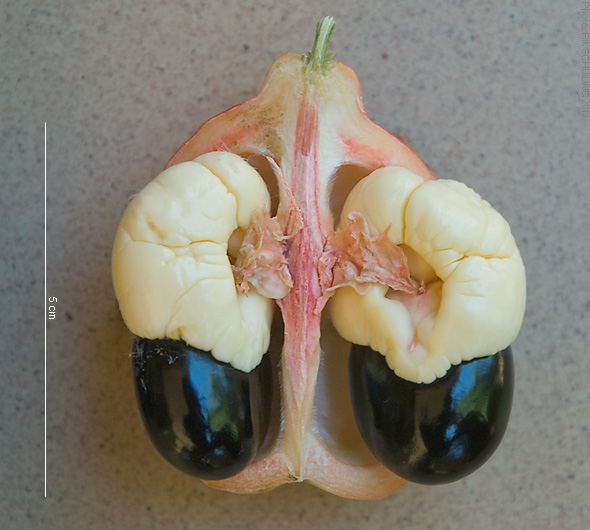
|
|
|
|
Post by haysoos on Jun 11, 2016 8:50:59 GMT -5
I've smelled durian before, and felt absolutely no desire to try to eat one. Finding out it has a high sulfur content makes even less likely to try it. I can't eat any sort of Brassicate (cabbage, mustard, broccoli, etc) because they all taste like pure sulfur to me. Bleech.
I mentioned earlier (in regards to the Triffids) that I ran a role-playing game where the players infiltrated a Fourth Reich genetic engineering facility. That installation was known as the Akee Facility, and extracts from the brain-like aril of the Ackee fruit were used to grant intelligence to other genetically manipulated plant species.
|
|
moimoi
AV Clubber  
Posts: 5,090 
|
Post by moimoi on Jun 13, 2016 15:03:27 GMT -5
|
|
|
|
Post by MrsLangdonAlger on Jun 13, 2016 19:51:15 GMT -5
I've tried that, but in a little lozenge form. It was really interesting! |
|
|
|
Post by haysoos on Jun 14, 2016 10:34:01 GMT -5
I've tried that, but in a little lozenge form. It was really interesting! I've always wanted to try the berries, but never found a source. But it turns out Amazon has the lozenges!! Ordered, and on the way! |
|
moimoi
AV Clubber  
Posts: 5,090 
|
Post by moimoi on Jun 20, 2016 1:40:44 GMT -5
post delayed on account of out-of-town guests...watch this space...  |
|
moimoi
AV Clubber  
Posts: 5,090 
|
Post by moimoi on Jun 20, 2016 11:41:27 GMT -5
Everyday Edibles
From rarified gastronomic pleasures, we turn to everyday edibles – the stuff that keeps us alive. Such an abundance of sustaining plant life exists on earth that I’ll be doing two posts on the topic, presenting Exhibits A-D this week and Exhibits E-G next Sunday. Dig in! Exhibit A: Genus Taraxacum (Dandelion)
Origin: native to Eurasia and North America, but the two most common species worldwide, T. officinale and T. erythrospermum, were imports from Europe that now propagate as wildflowers in temperate regions of the world, growing in lawns, on roadsides, on disturbed banks and shores of water ways, and other areas with moist soil. Features: Common dandelion is known for its yellow flower heads that turn into round balls of silver tufted fruits that disperse in the wind. The heads are borne singly on a hollow stem that is usually leafless and rises 1–10 cm or more above the leaves. Stems and leaves exude a white, milky latex when broken. Fun Facts: - Dandelions are thought to have evolved about 30 million years ago in Eurasia. They have been used by humans for food and as an herb for much of recorded history. Dandelion leaves and buds are part of traditional Kashmiri, Slovenian, Sephardic, Chinese, and Korean cuisines. The flower petals, along with other ingredients, usually including citrus, are used to make dandelion wine. The ground, roasted roots can be used as a caffeine-free dandelion coffee. Dandelion was also traditionally used to make the traditional British soft drink "dandelion and burdock", and is one of the ingredients of root beer. It has been used in a saison ale called Pissenlit (the French word for dandelion, literally meaning "wet the bed") made by Brasserie Fantôme in Belgium. Also, dandelions were once delicacies eaten by the Victorian gentry, mostly in salads and sandwiches served with hard boiled eggs. Dandelion leaves contain abundant vitamins and minerals, especially vitamins A, C, and K, and are good sources of calcium, potassium, iron, and manganese.
- The Latin name Taraxacum originates in medieval Persian writings on pharmacy. The Persian scientist Al-Razi around 900 AD wrote "the tarashaquq is like chicory" and around 1000 AD, Ibn Sina wrote a book chapter on Taraxacum. Gerard of Cremona, in translating Arabic to Latin around 1170, spelled it tarasacon. The English name, dandelion, is a corruption of the French dent de lion meaning "lion's tooth", referring to the coarsely toothed leaves. The plant is also known as blowball, cankerwort, doon-head-clock, witch's gowan, milk witch, Irish daisy, monks-head, priest's-crown, and puff-ball. The English folk name "piss-a-bed" (and indeed the equivalent contemporary French pissenlit) refers to the strong diuretic effect of the plant's roots. In various northeastern Italian dialects, the plant is known as pisacan ("dog pisses"), because they are found at the side of pavements.
- Dandelions secrete latex when the tissues are cut or broken, but in the wild type, the latex content is low and varies greatly. T. kok-saghyz, often abbreviated as TKS and commonly known as the Kazakh dandelion, rubber root, or Russian dandelion, is a species native to Kazakhstan that is notable for its production of high quality rubber. T. kok-saghyz was discovered in 1932 by the Soviet Union in an effort to find a domestic source of rubber and was cultivated on a large scale in the Soviet Union between 1931 and 1950, as well as in the United States, the UK, Germany, Sweden and Spain during World War II as an emergency source of rubber when supplies from rubber trees in Southeast Asia were threatened. Using modern cultivation methods and optimization techniques, scientists in Germany have developed a cultivar that is suitable for commercial production of natural rubber. The latex produced exhibits the same quality as rubber from rubber trees. As of May 2014, the first prototype test tires made with blends from dandelion-rubber are scheduled to be tested on public roads over the next few years.
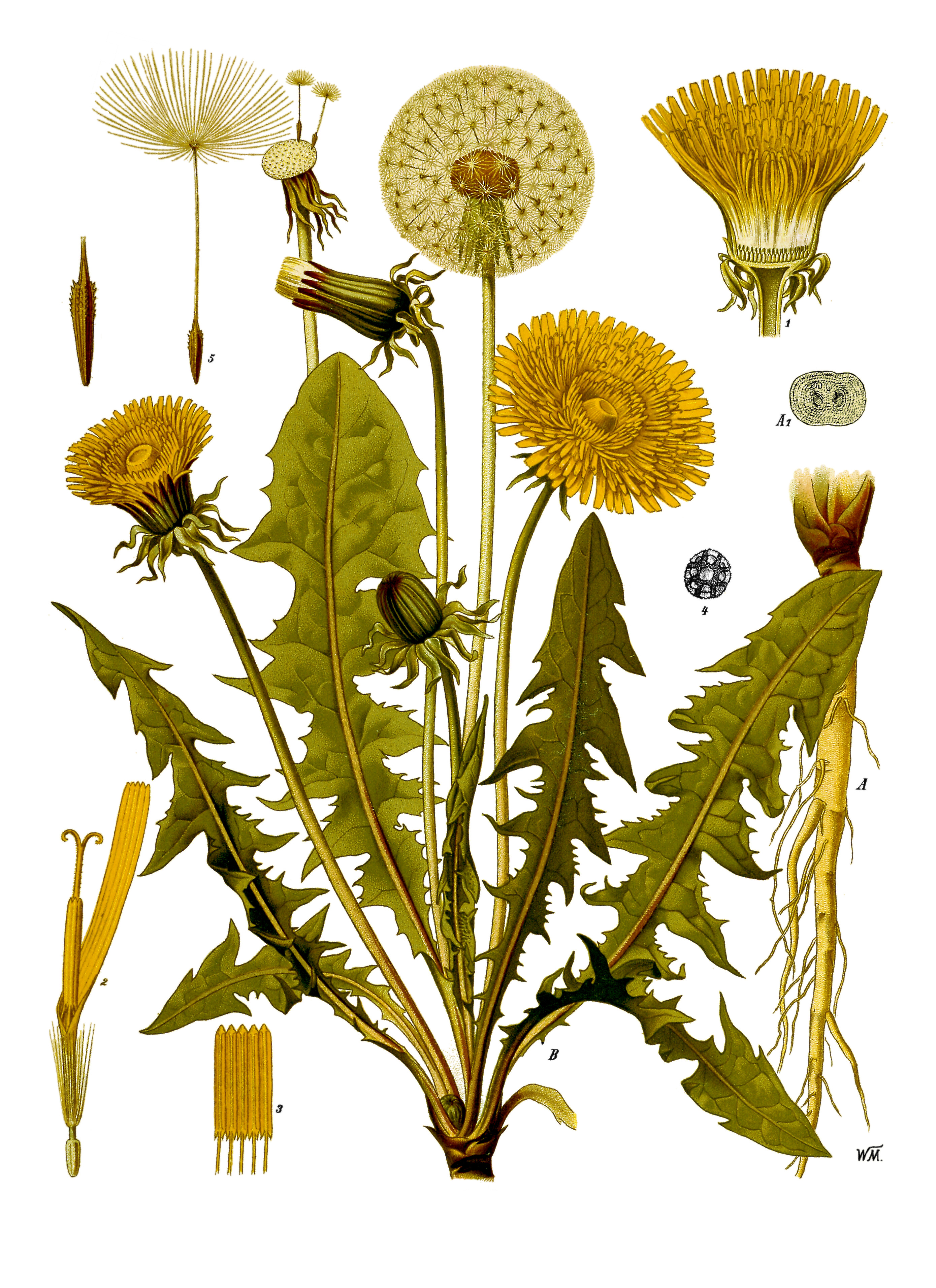   Exhibit B: Genus Cichorium (Chicory - varieties include radicchio, Belgian endive, French endive, red endive, sugarloaf, escarole, and witloof/witlof) Exhibit B: Genus Cichorium (Chicory - varieties include radicchio, Belgian endive, French endive, red endive, sugarloaf, escarole, and witloof/witlof)
Origin: Chicory is a native plant of western Asia, North Africa and Europe. It lives as a wild plant on roadsides in its native Europe, and now common in North America, China, and Australia, where it has become widely naturalized. Features: A relative of the dandelion, common chicory has a tough, grooved, hairy stem, from 30 to 100 cm (10 to 40 in) tall. The leaves are stalk-like and the flower heads are 2 to 4 cm wide--usually bright blue, rarely white or pink. It flowers from July until October. Leaf chicory, or endives, are closely related leaf vegetables in a variety of forms. Fun Facts: - The chicory plant is one of the earliest cited in recorded literature. Horace mentions it in reference to his own diet, which he describes as very simple: "Me pascunt olivae, me cichorea, me malvae" ("As for me, olives, endives, and mallows provide sustenance"). The cultivated chicory plant has a history reaching back to ancient Egyptian times. In certain sericulture texts, it is said that the primary caretaker of the silkworms, the "silkworm mother", should not eat or even touch it. The chicory flower is often seen as inspiration for the Romantic concept of the Blue Flower (e. g. the German 'Blauwarte' - 'blue lookout by the wayside'). It could open locked doors, according to European folklore.
- In 1766, Frederick the Great banned the importation of coffee into Prussia, leading to the development of a coffee-substitute by Brunswick innkeeper Christian Gottlieb Förster, who gained a concession in 1769 to manufacture it in Brunswick and Berlin. Lord Monboddo describes the plant in 1779 as the "chicoree", which the French cultivated as a pot herb. In Napoleonic Era France, chicory frequently appeared as either an adulterant in coffee, or as a coffee substitute. In the United States, chicory root has long been used as a substitute for coffee in prisons. By the 1840s, the port of New Orleans was the second largest importer of coffee (after New York). Louisianans began to add chicory root to their coffee when Union naval blockades during the American Civil War cut off the port of New Orleans, thereby creating a long-standing tradition. It was also used in the United Kingdom during the Second World War, where Camp Coffee, a coffee and chicory essence, has been on sale since 1885. It has been more widely used during economic crises such as the Great Depression in the 1930s and during World War II in Continental Europe. Chicory, with sugar beet and rye, was used as an ingredient of the East German Mischkaffee (mixed coffee), introduced during the "East German coffee crisis" of 1976-79. As a coffee additive, it is also mixed in Indian filter coffee, and in parts of Southeast Asia, South Africa, and southern United States, particularly in New Orleans.
- The Cherokee use an infusion of the root as a tonic for nerves and the Iroquois use a decoction of the roots as a wash and apply a poultice of it to chancres and fever sores. Chicory was listed as one of the 38 plants that are used to prepare Bach flower remedies, a kind of alternative medicine. Chicory is also well known for its toxicity to internal parasites. Studies in New Zealand indicate that ingestion of chicory by farm animals results in reduction of worms, which has prompted its widespread use as a forage supplement.
  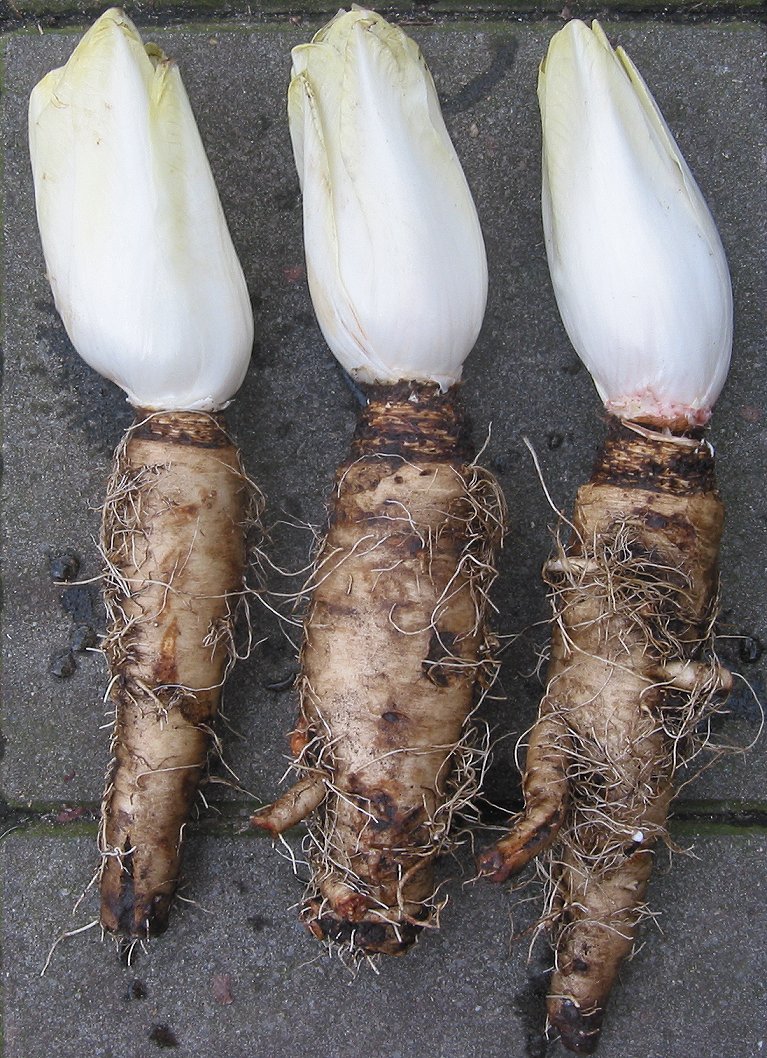 Exhibit C: Genus Pueraria (Kudzu) – as requested by 狼✧ʕ̢̣̣̣̣̩̩̩̩·͡˔·ོɁ̡̣̣̣̣̩̩̩̩✧吠え Exhibit C: Genus Pueraria (Kudzu) – as requested by 狼✧ʕ̢̣̣̣̣̩̩̩̩·͡˔·ོɁ̡̣̣̣̣̩̩̩̩✧吠え
Origin: Native to much of eastern Asia, Southeast Asia, and some Pacific islands, the name comes from the Japanese kuzu (クズ or 葛), which was written "kudzu" in historical romanizations. Features: A climbing, coiling, and trailing perennial vine, Kudzu spreads by vegetative reproduction via runners that root at the nodes to form new plants and by rhizomes. Kudzu will also spread by seeds, which are contained in pods and mature in the autumn, although this is rare. Where these plants are naturalized, they can be invasive and are considered noxious weeds. The plant climbs over trees or shrubs and grows so rapidly that it kills them by heavy shading. For successful long-term control of kudzu, it is not necessary to destroy the underground system, which can be extremely large and deep. It is only necessary to use some method to kill or remove the kudzu root crown and all rooting runners. The root crown is a fibrous knob of tissue that sits on top of the roots. Crowns form from multiple vine nodes that root to the ground, and range from pea- to basketball-sized.The older the crowns, the deeper they tend to be found in the ground. Nodes and crowns are the source of all kudzu vines, and roots cannot produce vines. If any portion of a root crown remains after attempted removal, the kudzu plant may grow back. Fun Facts: - The roots contain starch, which has traditionally been used as a food ingredient in East Asia. In Vietnam, the starch called bột sắn dây is flavored with pomelo oil and then used as a drink in the summer. In Japan, kuzuko starch is used in dishes including kuzumochi, mizu manjū, and kuzuyu tea. It also serves as a thickener for sauces, and can substitute for cornstarch. The flowers are used to make a jelly that tastes similar to grape jelly. Nearby bee colonies may forage on kudzu nectar during droughts as a last resort, producing a low-viscosity red or purple honey that tastes of grape jelly or bubblegum.
- Kudzu was introduced to the United States as an ornamental bush and an effortless and efficient shade producer at the Philadelphia Continental Exposition in 1876. In the 1930s and '40s, the vine was rebranded as a way for farmers to stop soil erosion. Southern farmers were given about eight dollars an acre to sow topsoil with the invasive vine. The cultivation covered over one million acres of kudzu. Today, the species P. montana is extensively reported across the eastern seaboard, with the heaviest infestations in Georgia, Alabama, and Mississippi. During World War II, kudzu was also introduced to Vanuatu and Fiji by United States Armed Forces to serve as camouflage for equipment, where it is now a major weed. The city of Chattanooga, Tennessee, has undertaken a trial program using goats and llamas to graze on the plant. Similar efforts to reduce widespread nuisance kudzu growth have also been undertaken in the cities of Winston-Salem, North Carolina and Tallahassee, Florida.
- P. tuberosa, known as Indian or Nepalese Kudzu is facing extinction in the wild because of herb hunters who trade the tubers illegally to agents of pharmaceutical or Ayurvedic companies. In the black market, about 10 kg of the red variety kudzu tuber is believed to fetch hundreds of thousands of rupees. The tubers are not disturbed from the plant, but the agents draw the juice of the tuber using syringes.
- Kudzu fiber has long been used for fiber art and basketry. The long runners which propagate the kudzu fields and the larger vines which cover trees make excellent weaving material. Some basket makers use the material green. Others use it after splitting it in half, allowing it to dry and then rehydrating it using hot water. Both traditional and contemporary basketry artists use kudzu. Kudzu fiber, known as ko-hemp, is used traditionally to make clothing and paper, and has also been investigated for industrial-scale use. In the Southern United States, kudzu is used to make soaps, lotions, and compost. It may become a valuable asset for the production of cellulosic ethanol.
- In traditional Chinese medicine, where it is known as gé gēn (Chinese: 葛根), kudzu is considered one of the 50 fundamental herbs. It is used to treat tinnitus, vertigo, and Wei syndrome (superficial heat). Kudzu has been used as a remedy for alcoholism and hangover. The root was used to prevent excessive consumption, while the flower was supposed to detoxify the liver and alleviate the symptoms afterwards.
 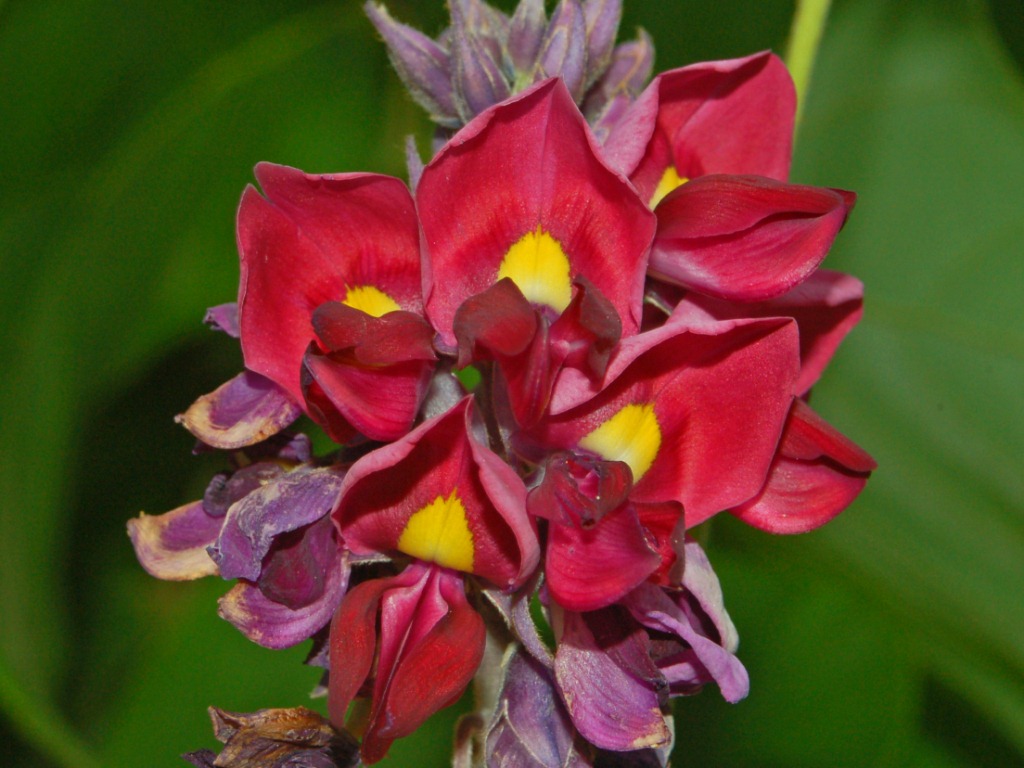  Exhibit D: Ceratonia siliqua (Carob, Locust Bean) – as requested by Lord LucanOrigin: Exhibit D: Ceratonia siliqua (Carob, Locust Bean) – as requested by Lord LucanOrigin: The carob tree is native to the Mediterranean region, including Southern Europe, Northern Africa, the larger Mediterranean islands, the Levant and Middle-East of Western Asia into Iran; and the Canary Islands and Macaronesia. Features: A flowering evergreen shrub or tree in the pea family, it is widely cultivated for its edible pods and as an ornamental tree in gardens. The C. siliqua tree grows up to 15 m (49 ft) tall. The crown is broad and semi-spherical, supported by a thick, sculptural trunk with brown rough bark and sturdy branches. Most carob trees are dioecious, some are hermaphrodite. The male trees do not produce fruit. The trees blossom in autumn, with small, numerous flowers spirally arranged in catkin-like bunches borne on spurs from old wood and even on the trunk. Male flowers are known to produce the fairly distinct odor of semen. The fruit is a legume (also known less accurately as a pod), that can be elongated, compressed, straight, or curved and takes a full year to develop and ripen. Fun Facts:
- The term "carat", the unit by which precious metal and stone weight is measured, is derived from the Greek word kerátiοn (κεράτιον), alluding to an ancient practice of weighing gold and gemstones against the seeds of the carob tree by people in the Middle East. The system was eventually standardized, and one carat was fixed at 0.2 grams.
- Carob is mildly sweet and is used in powdered, chip, or syrup form as an ingredient in cakes and cookies, and as a substitute for chocolate. The ripe, dried pod is often ground to carob powder, which is used to replace cocoa powder. Carob bars, an alternative to chocolate bars, are often available in health-food stores. While chocolate contains levels of theobromine which are toxic to some mammals, carob contains absolutely no caffeine and no theobromine, so is used to make chocolate-flavored treats for dogs.
- Carob was a common sweetener in Ancient Egypt was used in the hieroglyph for "sweet" (nedjem). The carob tree is mentioned with reverence in "The Epic of Gilgamesh", one of the earliest works of literature in existence. Subsistence on carob pods is mentioned in the Talmud, along with a parable of altruism, commonly known as "Honi and the Carob Tree", which posits that a carob tree takes 70 years to bear fruit; meaning that the planter will not benefit from his work, but works in the interest of future generations (in actuality, the fruiting age of carob trees varies). In the New Testament, in which Matthew 3:4 reports that John the Baptist subsisted on "locusts and wild honey", the Greek word translated "locusts" may refer to carob pods, rather than to grasshoppers. In the Parable of the Prodigal Son (Luke 15:16), when the Prodigal Son is in the field in spiritual and social poverty, he desires to eat the pods that he is feeding to the swine because he is suffering from starvation. A traditional sweet, eaten during Lent and Good Friday, is also made from carob pods in Malta. Dried carob fruit is traditionally eaten on the Jewish holiday of Tu Bishvat.
- In Cyprus, carob syrup is known as Cyprus's black gold, and is widely exported. In Malta, a syrup (ġulepp tal-ħarrub) is made out of carob pods. This is a traditional medicine for coughs and sore throat. Carob syrup is also used in Crete as a natural sweetener, and is considered a natural source of calcium. It contains three times more calcium than milk. It is also rich in iron, phosphorus, and natural fibers (due to its strong taste, it can be mixed with orange or chocolate). Carob juice drinks are traditionally drunk during the Islamic month of Ramadan. Compote, liqueur, and syrup made from crushed carob pods are consumed in Turkey, Malta, Portugal, Spain, and Sicily.
      More edibles, including requests, to come next week! More edibles, including requests, to come next week!
|
|
|
|
Post by haysoos on Jun 21, 2016 11:49:35 GMT -5
When I saw this dandelion gif earlier this week, I literally laughed out loud (something that rarely actually happens): i.imgur.com/1Eh9Rn4.gifv |
|